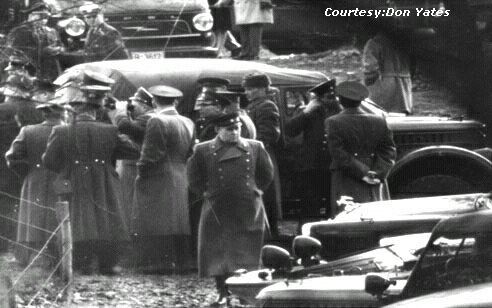AN INCIDENT IN BERLIN
This is just another in a long line of incidents in Berlin at the time of the 'Cold War' between the Warsaw Pact countries of Eastern Europe led by Russia and the NATO countries of Western Europe led by the United States of America, from the end of World War 2 until 1989 when the "Berlin Wall" , known to soldiers stationed in Germany as the 'Grenz Fence', was torn down.
During the afternoon of the 6th April 1966, two Russian twin-seat fighter aircraft took off from the airport at Finowfurt bound for another airport in the German Democratic Republic. Their route was to take them over the British sector of Berlin.
The aircraft were Yak28's, and had radar equipment superior to that of the Allies at the time.
One of the aircraft, piloted by Lt.Col.Juri Janow with his navigator, Capt. Boris Kapustin, was experiencing a loss of power in one of its engines. Kapustin signalled the problem to his controller who ordered him to attempt an emergency landing in the Russian sector of Berlin, but this was impossible. He managed to steer it into the water at the Heer Strasse end of the Havelsee called the Stossensee. The two men failed to eject and went to the bottom with the aircraft. It was a miracle that the aircraft narrowly missed a built-up area, and the possibility of great loss of life!
British military personnel were immediately rushed to the site where the Royal Military Police cordoned off the area as it so happened that a Russian bus with change-over guards for the Spandau Prison came upon the scene. The RMP ordered the Russians to remain on the bus and a tense situation was apparent.
Meanwhile, the British authorities had set up a salvage operation, promising the Russians through translators that both the aircraft wreckage and bodies would be recovered and handed over as soon as possible.
What the Russians didn't know, even if they suspected it, was that the British were stalling for time. They knew that the aircraft had a sophisticated radar dish on board and wanted to examine it together with the engines!
A barge with lifting aparatus was positioned above the wreck. Underneath, divers were working frantically to remove the engines and radar dish. Unknown to the Russians these parts were fixed to a rope and towed under water to a remote lakeside spot, quickly boxed up and taken to RAF Gatow and then flown to the Royal Aeronautical Establishment at Farnborough. After examination, and in the space of 48 hours the engines were returned to the site as though nothing untoward had happened! The radar dish was kept. RAE staff also went to the site.
The next day the two bodies were handed to the Russians and at midnight, all of the wreckage was taken to the Russian side of the Havelsee and handed over. The Russians never let on that the radar dish was not there and had to believe that it was still stuck in the mud at the bottom of the lake!
Don Yates and Terry Messer were at the scene and have commented as follows:
"Interestingly, I was at Theodore H..Platz when I got a message from O saying that there had been a report of a traffic accident involving a 'plane at the Havel Bridge and to investigate. I thought that it might be a hoax but proceeded as you do! Two German civilians were standing on the bridge looking into the river. I informed O who told me to stay and report. Shortly after all hell broke loose, SO3 PRO and wall and wire patrols arrived, but just before them the Russian bus on its way to change duties either at Tiergarten or Spandau. I remember refusing to let the Russians out of the bus, and as you can imagine they were not too pleased. It was a very long night because I and the others from the day shift were not relieved. I can honestly say that I was the first Brit on the scene. We spent a few other days there. too!""
Don Yates.
"Vic Leventhall was the most qualified guy in the Berlin Sub-Aqua Club He was the first diver to go and have a look at the Russian Yak 'plane at the bottom of the Havel at the request of the Brigade Commander, Brig. Taylor. The club got all new kit from the army for their help."
Terry Messer.

A party of RMP from 247 Pro.Coy. on way to secure the area.
 Lifting gear with wreckage.
Lifting gear with wreckage.
 A Close-up of the wreckage.
A Close-up of the wreckage.
 A group of Russian officers at the site.
A group of Russian officers at the site.
 A YAK28-the type of aircraft which crashed.
A YAK28-the type of aircraft which crashed.
 Lifting gear with wreckage.
Lifting gear with wreckage.
 A Close-up of the wreckage.
A Close-up of the wreckage.
 A group of Russian officers at the site.
A group of Russian officers at the site.
 A YAK28-the type of aircraft which crashed.
A YAK28-the type of aircraft which crashed.